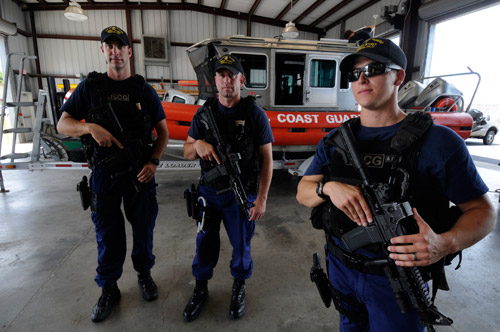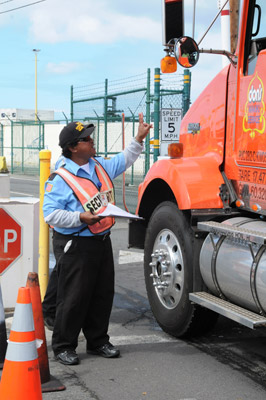Post-9/11 Hawaii sees security boost

The Coast Guard's Maritime Safety and Security Team was created in the wake of 9/11. Maritime Enforcement Specialist Guy Watts, Gunner's Mate Jerry Hatfield and Lt. Seth Craven stood yesterday with their MK18 rifles.

A guard stopped and checked a truck entering Pier 1 yesterday at Honolulu Harbor.


A SWAT team for the Coast Guard, a new identity check system at Hawaii’s harbors and an advanced-imaging screening system at Honolulu Airport are some of the changes made since 9/11 to safeguard the state from terrorist attacks.
No fewer than six federal, state and county agencies are part of the anti-terrorism efforts that collectively belong to the Joint Terrorism Task Force, also known as the Hawaii Emergency Preparedness Executive Committee.
"Our facilities are much safer than they were prior to 9/11," said state Transportation Director Brennon Morioka, whose agency is tasked with maintaining Hawaii’s airport and harbor facilities.
Some of the heightened security measures may pose inconveniences, "but it’s also a very different world we live in," he said. "I think for the most part, people have come to accept it."
Agencies declined to say how many personnel they have in Hawaii devoted to fighting terrorism, citing security reasons, but nearly all said they have bulked up.
The U.S. Coast Guard created the Maritime Safety and Security Team, basing a unit at Sand Island, said Capt. Joanna Nunan, sector commander for Honolulu, who also serves as port captain. "It’s essentially a federal maritime SWAT team with highly trained personnel that provides an extra layer of security to seaports, waterways and facilities," Nunan said.
Don't miss out on what's happening!
Stay in touch with breaking news, as it happens, conveniently in your email inbox. It's FREE!
Like other units, the Honolulu team comes with 71 active duty and 33 reserve personnel, and as many as six armed response boats, she said. Honolulu got its unit in 2005 and is one of only about 15 ports with such a team.
At the harbors, in conjunction with the state Transportation Department, the Coast Guard instituted a new Transport Worker Identification Card program at facility gates, making it more difficult for those not working at the docks to gain entry, Nunan said.
After 9/11, the Transportation Security Administration took over security of the country’s transportation systems. Its most visible impact is at the nation’s airports, where TSA officers now are in charge of security checkpoints for both passengers and baggage.
Besides additional personnel, Hawaii’s airports now have behavior detection officers observing those about to board planes, bomb appraisal officers who are trained specifically to spot explosives, and dog teams that screen cargo, said Dwayne Baird, a TSA public information officer based in Utah.
Later this year, Honolulu Airport will join Lihue Airport and more than 200 other facilities in receiving advanced imaging technology machines that will screen passengers for both metallic and non-metallic threats, including weapons and explosives. The machines can detect items concealed under clothing.
U.S. Customs and Border Patrol, created in 2003, is tasked with controlling the people and goods that come into the country from ports of entry, be they at harbors and piers, airports or the borders the U.S. shares with Canada and Mexico.
Under the Container Security Initiative program, the agency assigns personnel to seaports around the world to assist in the inspection and screening of cargo that is U.S.-bound, said James Kosciuk of the Customs and Border Patrol Hawaii public affairs office.
Those shipping to the U.S. also must adhere to strict cargo reporting requirements implemented after 9/11. For instance, a manifest detailing all items destined for the U.S. is required at least 24 hours before cargo can leave a foreign seaport. Aircraft pilots, meanwhile, now require an electronic manifest be filed four hours before a plane is expected to land at a U.S. airport.
Customs and Border Control monitors only cargo coming in from foreign countries, not other states, Kosciuk said.
The Honolulu Police Department established the Anti-Terrorism Unit for intelligence gathering and information sharing, said HPD Chief Louis Kealoha in e-mail responses to questions.
The unit’s officers "monitor national and international incidents and distribute anti-terrorism information to other HPD units," Kealoha said.
HPD also has an anti-terrorism hot line for the public (225-5473). Activities considered suspicious that should be reported include people taking photos of bridges, power plants or other infrastructure, or people asking questions about building security details.
The state Department of Defense, meanwhile, has offered its expertise to help "harden" surveillance for possible terrorism activity not just at military and government sector facilities, but also key commercial buildings such as utility plants and financial centers around the island, said Lt. Col. Chuck Anthony, agency spokesman.
Many anti-terrorism agencies said the most important improvement has been the partnerships they’ve formed.
"We are constantly working together to share information, to share resources, to exercise together, to plan together, and to evaluate risks," said Nunan.



